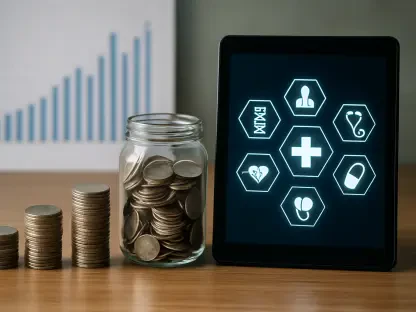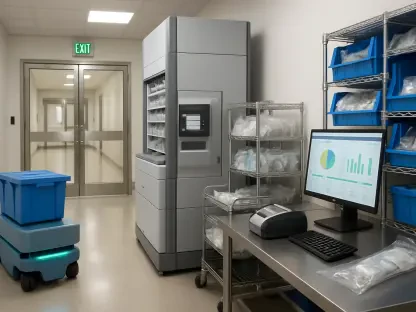The current healthcare system struggles to capture the complete picture of an individual’s health due to the limited scope and accessibility of traditional electronic medical records (EMRs). Social determinants of health (SDOH), which include factors such as socioeconomic status, education, and social support, play a crucial role in shaping health outcomes. The integration of blockchain technology offers a novel approach to address these limitations, enabling the comprehensive management of SDOH and improving overall healthcare delivery.
The Impact of Social Determinants on Health Outcomes
Understanding SDOH
Social determinants of health have a significant influence on individual health outcomes. Factors such as economic stability, education, and social networks are crucial in determining overall health status. Economic stability affords individuals the ability to meet basic needs, access healthcare services, and live in healthier environments. Education enhances understanding and management of personal health, leading to informed health decisions and healthier lifestyle choices. Thus, socio-economic factors hold equal, if not greater, importance compared to clinical factors in influencing individual health levels.
Research indicates that these non-clinical factors can be just as important as medical care in preventing disease and promoting wellness. A well-educated individual is more inclined to understand the importance of preventive care, adhere to medical prescriptions, and recognize early signs of health issues. Social networks and community support also play pivotal roles in emotional well-being while providing practical help in times of need. Hence, these layers of interaction between socio-economic elements and health behaviors underline the necessity of addressing SDOH comprehensively in healthcare frameworks.
The Role of Environmental Conditions
Environmental conditions play a critical role in shaping the health and behavior of organisms in an ecosystem. Factors such as temperature, humidity, and soil composition can significantly influence the survival and reproduction of species. Understanding these conditions is crucial for conservation efforts and for predicting the impacts of climate change on biodiversity.
Environmental conditions, including housing and neighborhood safety, directly impact physical and mental health. Access to clean air, safe parks, and adequate housing can lead to healthier lifestyles and outcomes. Living in a safe, clean environment reduces exposure to pollutants and hazards that cause diseases. Parks and recreational areas provide spaces for physical activity, which is fundamental to preventing chronic diseases such as diabetes and heart conditions. Meanwhile, adequate housing is essential for mental health, offering stability and reducing stressors associated with poor living conditions.
The relationship between environment and health has been well-documented, highlighting the importance of addressing these determinants in healthcare planning. Environmental factors are frequently intertwined with socio-economic determinants, as financially disadvantaged populations are more likely to live in environments with unhealthy conditions. Consequently, improving environmental conditions for vulnerable communities can significantly elevate public health standards. Healthcare systems must recognize these associations and integrate environmental health into broader health initiatives to foster healthier populations.
Limitations of Current Electronic Records
While electronic records offer numerous advantages over traditional paper records, they are not without their limitations. One significant challenge is ensuring the security and privacy of sensitive information, as electronic records are vulnerable to cyberattacks and data breaches. Additionally, there can be interoperability issues between different electronic health record (EHR) systems, making it difficult to share information seamlessly across various healthcare providers. Despite advancements in technology, the high costs associated with implementing and maintaining EHR systems can also be a barrier for some healthcare facilities. Furthermore, the requirement for continuous updates and staff training to keep up with evolving software can be resource-intensive.
EMRs and Clinical Data
Electronic medical records primarily focus on capturing clinical data related to diagnosis and treatment. They often fail to encompass broader social and environmental factors affecting patient health. This restricted focus results in an incomplete patient profile, thereby hindering the ability of healthcare providers to deliver holistic care. When healthcare decisions are based solely on clinical information, the intervention may not fully address the underlying causes of health conditions that are often rooted in social and environmental determinants.
This limitation results in an incomplete patient profile, hindering healthcare providers’ ability to deliver holistic care. Without considering a patient’s socio-economic status, education level, and living conditions, providers may overlook crucial aspects that influence treatment efficacy and patient adherence. Holistic care requires a detailed understanding of the patient’s lifestyle and external pressures. Therefore, the exclusion of SDOH from EMRs is a critical gap that needs addressing through innovative solutions.
Challenges with ICD-10-CM Codes
While ICD-10-CM codes provide some insight into social determinants, their use is limited. Economic incentives and restricted access outside EMR systems contribute to these challenges. Physicians may not be incentivized to record SDOH due to the absence of reimbursement structures or the additional time required to document non-clinical factors. Moreover, the integration of SDOH data into EMRs is hindered by technical barriers and inconsistent coding practices, limiting the usefulness of such codes for comprehensive patient care.
Addressing these limitations requires innovative solutions that go beyond current EMR capabilities. Blockchain technology offers a promising approach by enabling secure, decentralized data management outside traditional EMR systems. Incorporating blockchain to manage SDOH data can help create a more complete and accessible patient profile, thus bridging the gap between clinical information and broader social health determinants. This approach can ultimately enable a more effective and personalized healthcare delivery system.
Potential of Blockchain in Healthcare
Secure Data Management
Blockchain technology offers robust capabilities for secure tracking and management of verifiable data. Its decentralized nature enhances data integrity and security. Unlike traditional databases, blockchain ensures that once data is entered, it cannot be altered or deleted easily, providing a permanent and tamper-proof record. This immutability is crucial for maintaining trust in sensitive health information, preventing unauthorized modifications, and ensuring the authenticity of the recorded data.
These characteristics make blockchain ideal for storing and sharing sensitive health information. Medical records, SDOH data, and patient histories can be securely documented and accessed by authorized parties with patient consent. Blockchain’s ledger system makes it possible to track every interaction with patient data, ensuring transparency and compliance with privacy regulations. This level of security and transparency is essential for fostering trust among patients and healthcare providers, which is critical in the context of sensitive health information.
Coordination and Data Access
Blockchain can facilitate improved coordination and access to trusted data among healthcare providers. Patient consent mechanisms ensure that data sharing adheres to privacy regulations. When patients authorize their data to be shared, blockchain can provide a secure and transparent mechanism for transferring this information across different healthcare entities. This coordination enables healthcare providers to access a holistic view of patient records, enhancing the effectiveness of diagnoses, treatments, and interventions.
This approach can improve care delivery by providing a comprehensive view of patient needs and interventions. With a full picture of a patient’s medical history, including SDOH and other non-clinical data, healthcare providers can tailor interventions that address both medical and socio-environmental factors influencing health. Efficient data exchange facilitated by blockchain reduces the risk of errors, enhances continuity of care, and ensures that all healthcare stakeholders are well-informed about the patient’s status, resulting in better-coordinated and patient-centric care delivery.
Enhancing Patient Trust
Overcoming Distrust
Healthcare systems often face distrust, particularly among underserved populations. Blockchain’s transparency and security features can help rebuild patient trust. Transparency in data handling and secure management practices reassures patients that their sensitive information is protected from unauthorized access and fraud. Underserved communities, which are often more vulnerable to data breaches and misuse, can benefit significantly from the trust-building capabilities of blockchain technology.
Ensuring data accessibility and protection is key to addressing this issue. Blockchain’s cryptographic security measures safeguard patient data, while its decentralized nature guarantees that control over the data remains with the patient. This empowerment through data ownership helps build trust, ensuring patients feel confident and willing to engage more actively with their care plans. Effective use of blockchain can thus address historical mistrust issues within the healthcare system and improve patient-provider relationships.
Addressing Vulnerabilities
Language barriers and low literacy levels are additional hurdles in health literacy. Blockchain can mitigate these challenges by making health data more accessible and understandable. Interactive features and user-friendly interfaces designed within blockchain applications can help patients navigate their health information easily. Simplifying medical jargon and providing data in multiple languages improves comprehension, allowing patients from diverse backgrounds to better understand their health status and the necessary interventions.
Engaging patients effectively requires technology that caters to diverse needs. Blockchain platforms can be designed to interact with various digital literacy levels, ensuring inclusivity. Additionally, patient education programs integrated into blockchain systems can provide necessary knowledge on data management and health literacy, fostering a more inclusive approach to healthcare. By addressing these vulnerabilities, blockchain technology can contribute to improved health outcomes through better patient engagement and empowerment.
Economic Incentives and Reimbursement Models
Value-Based Care
As healthcare costs continue to rise, value-based reimbursement models are gaining prominence. Managing social determinants of health (SDOH) is increasingly recognized as essential in these models for fostering comprehensive patient care. Value-based care emphasizes patient outcomes over service volume, incentivizing healthcare providers to deliver efficient, high-quality care. Recognizing SDOH within these models enables providers to address broader health factors, ultimately improving patient health outcomes and reducing costs.
Holistic approaches to care can improve patient outcomes and reduce overall costs. By incorporating SDOH data into care plans, providers can identify and address the root causes of health issues, leading to more sustainable health improvements. This comprehensive care model not only benefits patients by improving their overall well-being but also enhances healthcare system efficiency through the reduction of unnecessary hospitalizations and emergency room visits.
Financial Challenges
Underfunded and understaffed social service agencies pose challenges to implementing SDOH services. Blockchain integration can optimize resource allocation and intervention strategies. By providing a centralized platform for recording and accessing SDOH data, blockchain can help social service agencies streamline their operations, improve efficiency, and ensure that resources are directed to where they are needed most. This optimization is vital for addressing the constraints faced by underfunded agencies and maximizing the impact of limited resources.
Balancing clinical and non-clinical services is critical for sustainable healthcare delivery. By leveraging blockchain technology, the integration of social services and clinical care can be more effectively managed. This balance ensures that both medical treatments and essential social services are offered to address the full spectrum of patient needs. Effective resource management facilitated by blockchain can transform how social determinants are addressed within healthcare, making sustainable and holistic patient care a feasible objective.
Integration and Data Analytics
Incorporating SDOH Measurement
Hospitals and health systems are progressively incorporating SDOH measurements into their data analytics frameworks. This approach enhances care management and reimbursement capabilities. By integrating SDOH data into their analytics programs, healthcare providers can gain a comprehensive understanding of patient populations, identifying trends and correlations that might otherwise be overlooked. This enriched data landscape allows for more precise and effective interventions tailored to the unique needs of different demographic groups.
Comprehensive data analytics can identify trends and tailor interventions. Analyzing SDOH alongside clinical data provides insights into how various factors, such as economic challenges or lack of educational opportunities, impact patient health. These insights enable healthcare providers to develop targeted programs aimed at mitigating these social determinants, ultimately leading to improved health outcomes. Utilizing data to inform interventions ensures that healthcare strategies are both evidence-based and highly relevant to the populations they serve.
Leveraging Data for Population Health
Effective use of SDOH data can improve population health management. Blockchain’s secure data sharing enables more accurate health assessments and interventions. By creating a unified, immutable record of health and social data, blockchain facilitates extensive and reliable data analysis. This comprehensive view of population health can support public health initiatives, identifying high-risk groups and enabling preemptive measures tailored to those communities.
Analyzing these patterns can inform public health strategies and policies. Patterns and trends derived from SDOH data can reveal underlying issues, allowing policymakers and healthcare providers to create targeted interventions. For instance, if data indicates a high prevalence of certain diseases in economically disadvantaged areas, healthcare initiatives can focus on improving access to care and health education in those communities. By leveraging blockchain for comprehensive data analysis, public health strategies can be more responsive, targeted, and effective.
Challenges in Implementing SDOH Services
Prioritization and Intervention
Integrating SDOH services with clinical healthcare systems requires careful prioritization and strategic interventions. Addressing these challenges is essential for effective care. Successful integration depends on recognizing which social determinants have the most significant impact on health outcomes and prioritizing these in health strategies. Strategic interventions, informed by comprehensive data analysis, can be planned and implemented to address the prioritized determinants effectively.
Collaboration among stakeholders can streamline this process. Healthcare providers must work closely with social service agencies, policymakers, and community organizations to ensure that SDOH services are effectively integrated into the broader healthcare system. This collaborative approach helps align resources, coordinate care, and develop intervention strategies that are both comprehensive and sustainable. Effective communication and partnership among stakeholders are essential for removing barriers and optimizing health service delivery across various social domains.
Managing Data
Effective data management is crucial for integrating SDOH services. Blockchain provides a secure and efficient solution for handling sensitive and diverse data sets. By offering a decentralized and robust framework for managing health data, blockchain ensures data integrity and accessibility across different platforms and institutions. This technology handles large volumes of data while maintaining security and privacy, which is paramount when dealing with sensitive health and social information.
Implementing this technology can enhance data accuracy and accessibility. Blockchain’s immutable ledger ensures that once data is recorded, it remains unaltered, thereby maintaining the authenticity and reliability of the data. This reliability is essential for making informed healthcare decisions and planning effective interventions. Secure data sharing enabled by blockchain ensures all relevant stakeholders have the necessary access to accurate data, facilitating coordinated care and comprehensive management of patient health.
Role of Blockchain During the Pandemic
During the pandemic, blockchain played a pivotal role in ensuring transparency and efficiency in various sectors such as supply chain management, healthcare, and financial services. The technology facilitated secure and tamper-proof transactions, streamlined processes, and enhanced data sharing, thereby mitigating fraud and enabling better coordination among stakeholders. Blockchain’s ability to create decentralized and immutable records proved invaluable in tracing the movement of goods, verifying the authenticity of medical supplies, and managing financial transactions in a time of crisis.
Supporting Global Coordination
During crises such as the COVID-19 pandemic, blockchain can support global coordination efforts by systematically managing healthcare data, supply chains, and essential services. By providing a reliable and transparent platform for data sharing, blockchain enhances the ability of global health agencies and governments to coordinate their responses effectively. This system ensures that all parties have access to up-to-date and accurate information, which is critical during rapidly evolving health crises.
This capability enhances crisis response and resource allocation. Blockchain can track supplies, enabling better management and distribution of essential resources like PPE and medications. Accurate demand and supply assessments ensure timely delivery and prevent shortages. Moreover, transparent tracking of patient data and health services ensures that interventions are timely and reach the areas most in need, improving overall crisis management and minimizing the impact on public health.
Tracking Vaccination and Supply Chains
Blockchain technology aids in tracking vaccination activities and managing pharmaceutical supply chains. Its immutable ledger ensures accurate data recording and transparency. By providing a clear and unalterable record of vaccine distribution and administration, blockchain ensures accountability and prevents fraud or mismanagement. This transparency builds public trust in vaccination efforts and helps in tracking vaccination coverage across populations.
These functions are critical for public health safety and efficacy. Accurate supply chain tracking prevents shortages and ensures vaccines and medications are distributed efficiently and equitably. Real-time monitoring of vaccination activities allows health authorities to identify gaps and address them promptly, ensuring comprehensive coverage and herd immunity. Blockchain’s capabilities in tracking and managing these vital activities support the overall effectiveness and integrity of public health initiatives.
Financial Inclusion via Blockchain
Enhancing Access to Resources
Blockchain technology can improve financial inclusion for unbanked or under-banked populations by creating verifiable financial histories, facilitating access to credit-based resources. Many individuals, particularly in underserved populations, lack access to traditional banking systems, which can limit their ability to secure loans, open savings accounts, or engage in other financial activities. Blockchain can offer an alternative by providing secure digital identities and financial histories, enabling them to participate in the financial system.
Empowering marginalized populations through financial inclusion can lead to better health outcomes. Financial stability allows individuals to afford necessary healthcare services, medication, and healthy living conditions. By improving access to financial resources, blockchain can contribute to reducing the socioeconomic barriers that often hinder access to quality healthcare. Thus, financial inclusion becomes a critical component in addressing social determinants of health and improving the overall well-being of marginalized populations.
Reducing Economic Barriers
Economic barriers often hinder access to healthcare and essential services. Blockchain can streamline processes and reduce these barriers by creating transparent and efficient financial systems. For instance, digital wallets and decentralized finance (DeFi) platforms facilitated by blockchain can lower transaction costs and increase accessibility to funds. This efficiency is crucial for populations that face economic challenges and need affordable and easy access to financial services.
Secure and decentralized systems can reduce fraud and corruption, ensuring that financial aid and resources reach the intended recipients. By reducing transaction costs and enhancing transparency, blockchain makes financial services more accessible. This increased accessibility enables families and individuals to better manage their finances, access necessary healthcare services, and improve their living conditions. Blockchain thus plays a pivotal role in reducing the economic barriers that adversely impact health outcomes.
Enhancing Public Health Strategies
The current healthcare system faces significant challenges in capturing a complete picture of an individual’s health, mainly due to the limited scope and accessibility of traditional electronic medical records (EMRs). These records often fail to encompass the full range of factors influencing a person’s health. Social determinants of health (SDOH) – such as socioeconomic status, education level, and social support networks – significantly impact health outcomes but are often overlooked in conventional EMRs.
Integrating blockchain technology presents a promising solution to these limitations. Blockchain offers enhanced security, transparency, and the ability to manage comprehensive health data effectively. By incorporating SDOH into a blockchain-based system, healthcare providers can achieve a more holistic understanding of patient health. This approach enables the secure sharing of sensitive information, ensuring data integrity and privacy while enhancing access to vital health determinants.
Incorporating blockchain technology can transform healthcare delivery by providing a more robust framework for managing and analyzing health data. This innovation can support better decision-making, improve patient outcomes, and ultimately lead to a more effective and equitable healthcare system. Vast potential lies in leveraging blockchain to bridge the gap between traditional EMRs and the broader scope of health determinants that shape overall well-being.









